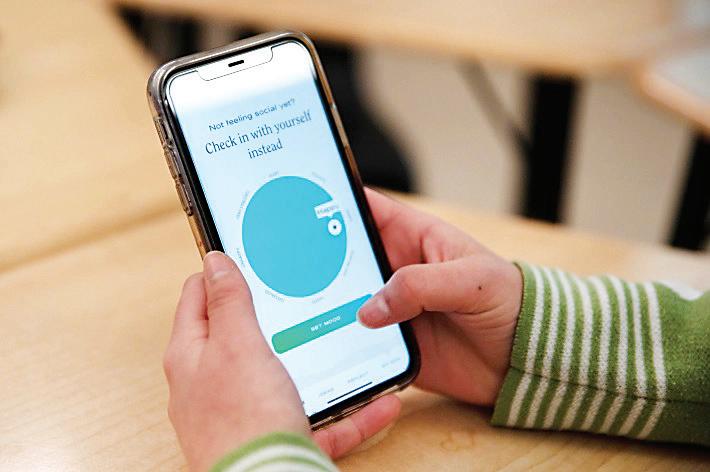
12 minute read
VOLUME 119 ISSUE
Unemployment rate drops to 4.1%
BY TAMARA CHUANG THE COLORADO SUN
Colorado’s economic recovery is going better than expected state labor offi cials said Monday, reporting that 98% of jobs lost when COVID struck have returned.
However, January’s 4.1% unemployment rate, the lowest since the pandemic began, is still higher than the 2.8% in February 2020, the month before the fi rst COVID-19 cases in Colorado were confi rmed.
“That was historically low. That was after the end of a very long economic expansion,” Ryan Gedney, senior labor economist at the state Department of Labor and Employment, said during a news conference on Monday. “As long as these trends hold … I could see the state reaching that 3% level in one or two years for sure.”
His confi dence is based on how many Coloradans are now part of the state’s labor force, which is larger than ever with more people employed or looking for work. The state’s labor force participation rate was 68.5% in January, or onetenth of a percentage point higher than in February 2020.
“Colorado’s labor force grew by over 17,000 in January. And since July of 2020 the state has added over 180,000 individuals to the labor force,” Gedney said. “On an annual basis, Colorado’s labor force participation rate increased from 67.4% in 2020 to 68.2% in 2021. That ranked as the fourth highest in the U.S. last year.”
By comparison, the U.S. rate last year was 61.7%.
While more people are part of the state’s labor force, Bureau of Labor Statistics data shows there are still around 132,000 Coloradans who are unemployed, compared with 86,000 who were unemployed in February 2020.
That only counts people who are working or actively looking for a job, said Steven Byers, a senior economist for Common Sense Institute, a Greenwood Village think tank focused on the state’s fi scal policies.
“Some people would say that understates or overstates the true unemployment rate depending on which way you go,” Byers said. “But when people take themselves out of the labor force and they’re no longer looking, that impacts those numbers. But the way that unemployment is measured has been constant for a long time. They don’t change the methodology so it’s consistent over time for what it measures.”
The state’s unemployment rate fell from 4.2% in December, a rate that was revised downward from 4.8%, according to labor offi cials. Colorado’s January rate is also close to the U.S. unemployment rate of 4.0% in January.
The falling unemployment rate refl ects more people returning to work, especially mothers who had dropped out of the workforce early on, likely to deal with their children and remote schooling or lack of child care options during the pandemic.
Byers is among economists keeping an eye on rising infl ation and its impact on small businesses and consumer spending habits.
“One other thing that we are kind of concerned about, though, is the house prices have just gotten exorbitant,” he said. “The question would be, is it just going to end up being a disadvantage to Colorado employers being able to lure people here and bring them in from out of state? That’s an area that is of concern as well.”
But Colorado’s pandemic economy hasn’t fully recovered yet, said Kathy A. White, executive director of Colorado Fiscal Institute, an organization that also focuses on fi scal policy.
“Colorado has recovered all but 5,500 jobs lost during the pandemic, but it needs another 38,100 jobs in order to keep up with the 1.4% growth in population that the state has experienced in the 23 months since the recession began,” White said in an email.
“Also, the fastest job recovery happened in industries with high income earners and lagged in industries with lower pay. poor quality jobs,” she added. “Those industries tend to have a higher percentage of women and people of color, who again, entered the pandemic with higher rates of unemployment and lower earnings. In short, the recovery has been uneven, despite these broad indicators, and so policymakers should be targeting resources and aid to the people who need it the most.”
There’s also uneven recovery in certain parts of the state. Strong job growth in Grand Junction and Colorado Springs amounted to job recovery rates of 124% and 113%, respectively. But the Greeley region has recovered just 44% of the jobs lost in the early pandemic.
That’s due to Greeley’s high concentration of oil and gas, an industry that hasn’t recovered as fast as the leisure and hospitality industry or the professional and business services fi eld, Gedney said. But Greeley’s a small part of the state. It lost roughly 11,700 jobs at the start of the pandemic and has regained 5,100. The Denver area lost 199,600 and has recovered 196,100.
“The state’s recovery rate is going to trend pretty closely with Denver’s, as that (region) represents over half of the state’s employment,” Gedney said.
He added, “There’s still some room in the unemployment rate, but I think the unemployment rate is going to drop relatively quickly in 2022 as there’s still a huge demand for labor and for fi lling jobs.”




A hiring sign hangs in the King Soopers deli department at the 58th and Independence location.
PHOTO BY JENNIFER LEDUC
This story is from The Colorado Sun, a journalist-owned news outlet based in Denver and covering the state. For more, and to support The Colorado Sun, visit coloradosun. com. The Colorado Sun is a partner in the Colorado News Conservancy, owner of Colorado Community Media.
Prepare for power outages today
WITH A HOME STANDBY GENERATOR
FREE
7-Year Extended Warranty*
No Clipping Required.
The AARP® Auto Insurance Program from The Hartford.1
FREE duffel bag when you request your free quote!3
ON AVERAGE, AARP MEMBERS ENJOY $5072 SAVINGS
ON AUTO INSURANCE when they switch from companies like GEICO, State Farm and Allstate
Your savings could be even more!
Call The Hartford 1-833-498-1989
Call The Hartford now to request a FREE money-saving quote. 1-833-498-1989
The Nod app was piloted across eight school districts

BY ERICA BREUNLIN THE COLORADO SUN

Barely out of bed and still waiting for the fog of sleep to lift, Ameera Sierra used to start her mornings staring at an endless stream of selfi es, tweets and Snapchat stories. It was almost a ritual for the 17-year-old: Roll over, turn off the alarm, grab the phone and begin scrolling, the glow from her screen the fi rst light of her day.
And it came with a pang of loneliness, particularly as she saw effortlessly happy lives portrayed on social media.
“Sometimes when I see that and I’m not living that particular life, it makes me feel like I’m doing something wrong or that I’m more alone,” she said. Now Ameera, a senior at Mountain Range High School in Westminster, is carving out a new relationship with her smartphone, thanks to a new app aimed at providing Colorado teens with a sense of connection and support, free of the noise of Facebook, Twitter and TikTok.
For the past few weeks, the teen has has turned to a new smartphone app designed to help Colorado teenagers relearn how to talk to their peers, form meaningful friendships and navigate lingering feelings of loneliness amid a two-year pandemic.
The Nod app, which is being introduced this semester at Mountain Range and schools in seven other districts, gives teens a way to track their sense of well-being, hone strategies to improve their mood when stressed or discouraged and rebuild social skills like giving others compliments or having deeper conversations.
“Students feel a lot less confi dent in their skills because they haven’t practiced them as much or they’ve been so comfortable engaging in online learning or chatting with people over digital platforms,” said Stacy Stansbury, a school psychologist at Mountain Range High School.
Common social skills aren’t so common anymore
The app was originally developed for college students by Grit Digital Health, a Denver-based technology fi rm focused on mental health, and the nonprofi t Hopelab of San Francisco, which serves as an incubator for projects that address the mental health of youth and young adults.
It was adapted for use by high school students with the help of the nonprofi t Colorado Education Initiative, and rolled out to participating school districts through a $490,000 grant from The Upswing Fund for Adolescent Mental Health, which supports organizations addressing student mental health.
Social skills that Stansbury said were “common knowledge” when she was in high school — such as striking up a conversation to recommend something to a classmate or following up on something a peer said the day before — are “not so common anymore.”
Even as teens can connect to one another instantly through their phones or social media platforms, they belong to “the loneliest living generation,” said Nathaan Demers, vice president of clinical programs and strategic partnerships and a clinical psychologist at Grit Digital Health.
He characterizes loneliness as “the gap between the relationships that I have and those which I desire.”
Loneliness among young people stems partly from a decrease in face-to-face interactions as technology has changed how people communicate — everything from the way friends stay in touch to the way people fi nd out what time a movie is playing. Social media often doesn’t help. When a person simply scrolls through social media liking posts and leaving comments, they’re not truly fulfi lling their need for connection, Demers said. Instead, they’re “social snacking,” meaning they’re feeling a sense of connection in the moment but one that quickly evaporates.
And loneliness among teens has grown exponentially during the pandemic. That places young people at a higher risk for other struggles, such as anxiety, depression, substance use, suicide and dropping out of school, Demers said.
The app encourages users to branch out and practice skills pertaining to fi ve different focus areas — forming deep relationships, expanding social circles, connecting over shared interests, feeling more confi dent and exploring opportunities after graduation. For instance, for students looking to broaden their social circle, the app might direct them to smile at fi ve people in a day or sit next to someone they don’t know in the cafeteria and start a conversation.
Confronting overwhelming feelings instead of escaping them
Grit Digital Health and Hopelab discovered how much high school students could benefi t from the Nod app after they opened it up to anyone during the pandemic and ended up attracting many high schoolers, Demers said.
Colorado Education Initiative helped recruit schools to take part in a pilot project. Their students’ feedback helped shape the app’s development, said Marcus Bratton, the nonprofi t’s director of implementation and partnership.
The organization will again check in with users at the end of the semester and consider whether to make any other tweaks.
As students continue exploring the app, the hope is that it will help them develop skills to manage their emotions before signifi cant depression, substance abuse, truancy or other challenges interfere with their lives, Bratton said.
“I hope that it inspires human connection for our young people,” he said, particularly as teens often struggle to feel understood, recognize they’re not the only ones facing loneliness and hesitate to exert themselves for fear of being rejected.
Stansbury introduced the app to Mountain Range High School students toward the end of last month and said she’s found comfort in being able to equip students with a tool that offers them the same kind of guidance she or a school social worker would.
“I think you can see the increase in anxiety and depression and suicidal ideation that’s happening everywhere,” she said, “and sometimes it feels like you don’t have anything to recommend, and now it feels like we do have something they could actually use … that will teach them ideas and strategies of how to reach their personal and social goals while building their confi dence and social connections.”
Senior Jarett Benedict has been using the app here and there to start his day with a focus on his mood,
Holly Days Spring Craft Show at the Grange
Friday, April 1st • 9 to 5 Saturday, April 2nd • 9 to 4
The Nod app, largely aimed toward adolescents and college students, was introduced to Mountain Range High School in February 2022. The app allows users to to set social and emotional goals, as well as assess their emotional states using mindfulness and motivational
psychology. PHOTO BY
OLIVIA SUN/THE COLORADO SUN VIA REPORT FOR AMERICA
SEE APP, P17
PAID ADVERTISEMENT
HSA: A healthy way to save for retirement
Many expenses in life are unpredictable. But you know you’ll always have to pay for medical bills and retirement. And you can help meet these costs with a Health Savings Account, or HSA.
If you have a high-deductible health plan, you may be eligible to contribute to an HSA. You contribute pre-tax dollars, which can reduce your taxable income, and your money grows tax-free. Plus, withdrawals are tax-free if they’re used to pay for qualified medical expenses.
The money in your HSA can be carried over from year to year – you aren’t obligated to “use it or lose it.” So, the funds not spent on annual medical expenses can continue to grow taxfree. And your HSA is portable – you can take it with you when you leave a job.
If you don’t need all the money in your HSA to pay for medical costs once you reach age 65, you can use it to help pay for other expenses penalty-free. Keep in mind, though, that these non-medical withdrawals are taxable.
An HSA can help you in various ways. If you have access to one, consider taking advantage of it.
This article was written by Edward Jones for use by your local Edward Jones Financial Advisor.
www.edwardjones.com Member SIPC
• Mutual Funds • Stocks • Bonds • IRAs, Roth IRAs, Simple IRAs & 401(k)s • CDs • Annuities • Life Insurance • Check Writing, Debit Cards & Direct
Deposit • Education Savings
Tony Merritt, AAMS® ,
Financial Advisor
150 Main Street, Suite 1 Fort Lupton, CO 80621 303-857-3983





